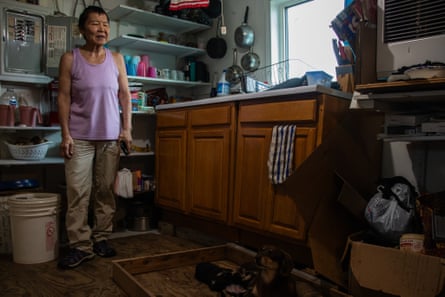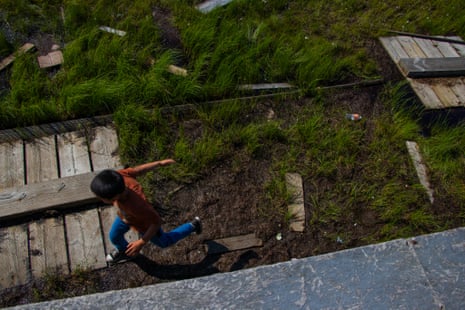Children splash gleefully in the river as adults cast fishing lines or head into the Alaska tundra to hunt. It’s a scene that has characterized summer days for centuries among the Yup’ik people who have long lived in south-western Alaska, where the village of Nunapitchuk stands. But, with temperatures in Alaska warming nearly four times faster than most parts of the globe, that way of life is about to change.
Homes in Nunapitchuk have been sinking into the permafrost, and residents have decided their only choice is to move the entire village to higher ground.
When the permafrost under Nunapitchuk melts, it mixes with the soil, creating an unstable, muck-like substance that local people call “Alaskan quicksand”. The phenomenon, along with rapid erosion from the coastline, has dangerously damaged key infrastructure in the village.
After a typhoon in October damaged electrical lines and raised the waterline even higher, Morris Alexie, the former tribal administrator of Nunapitchuk, said the village needed help now more than ever.
“With global warming, life has gotten worse. It has gotten worse for us to try and keep our livelihood going,” said Alexie. “Everywhere you look, you will see slanted homes filled with people. They’re starting to touch the ground, and homes are getting very close to the riverbank.”
Nunapitchuk is just one of 144 Native villages in Alaska that will need to relocate because of infrastructure damage caused by the climate crisis, according to a 2020 report by the Bureau of Indian Affairs.
Edna Chase, a 60-year-old mother in Nunapitchuk, is one of the approximately 750 residents whose houses have started to sink into the ground, making her home of 53 years nearly impossible to live in.

“There’s no more foundation, it’s under the ground,” Chase said, pointing towards her floor. Every 15 minutes, a makeshift machine pumps water from under the house to keep it from flooding.
Chase’s life revolves around keeping her home dry for her and her 15-year-old son. She has written Bible verses on her fridge, her door and her walls to keep faith that one day it will be better.
The village’s problems don’t stop with slanted houses. Its ground is so unstable that the only way to get around is on boardwalks, which are constantly in need of repair. Nunapitchuk’s only playground, a basketball court elevated above the ground, is filled with holes.
Nunapitchuk collectively voted in 2023 to relocate to a different spot three miles away. Alexie is in charge of leading the relocation efforts and said the new location stands on sand, instead of soil, which means it could last for centuries.
“It would be a joy, it would be a relief for, as you can see, it is high and dry over here,” he said.
Estimates show that relocating Nunapitchuk could cost about $230m, but the village has collected just a fraction of that amount. In 2022, Nunapitchuk received $2.2m to repair a police station, and in 2024, the Bureau of Indian Affairs awarded it $250,000 to design a master plan for relocation.
During his term, Joe Biden started to devote more attention to addressing climate relocation. From 2021 to 2024, the then president hosted the White House Tribal Nations Summit, where 574 tribes, including residents from Nunapitchuk, met with the administration to demand action. In 2022, the Department of the Interior created the Voluntary Community-Driven Relocation Program to bolster climate relocation and planning efforts for tribal communities.
The Biden administration earmarked more than $560m to help tribes cope with the climate crisis, including through relocation, but earlier this year, the Trump administration froze $100m earmarked to these communities before it was doled out.
“It seems like we were making some steps forward, and then this was like a step back again,” Alexie said.
Melissa Shapiro, a policy advocate and lawyer at Woodwell Climate, said that although the Trump administration had posed additional funding challenges for Nunapitchuk, the problem extends beyond this administration.
“It is a systematic issue.” Shapiro said. “ The Trump administration certainly is not favorable when it comes to climate adaptation support. It has obviously destabilized and weakened a lot of those supports, but it’s not like there was anything in place.”
In addition to the lack of federal help, one of the largest obstacles is the absence of a leading authority to coordinate the tribal relocations, said Alfredo Gómez, the director of the natural resources and environment team at the Government Accountability Office (GOA).
More than 20 different federal agencies, including the Federal Emergency Management Agency (Fema), the Bureau of Indian Affairs, the Denali Commission, the Department of Housing and Urban Development (HUD), the army corps of engineers and others, each have a different part to play in the relocation process.
after newsletter promotion
Since 2009, the GAO has given Congress multiple recommendations on how to handle climate relocations, but none have been fully implemented.

“It’s a piecemeal approach and it is not working well,” said Gómez. “Our recommendations are that a federal entity needs to be in charge of coordinating and helping the community make those moves.”
The White House did not respond to a request for comment about the administration’s funding cuts or lack of federal coordination over relocation efforts.
Even in Alaska, climate relocation does not seem to preoccupy much of the political landscape. CJ McCormick represented Alaska’s 38th district in the state’s house of representatives for two years. During his term, he saw harsh political pushback to climate relocation on both a state and national level.
“There are solutions to this problem that are being ignored because of bureaucracy and almost, frankly, willful ignorance,” McCormick said. “Even the ‘best’ administrations have only done the bare minimum.”
Meanwhile, the melting permafrost is creating a host of health problems, residents say.
The permafrost thawing has damaged the foundation of homes such that gaps in walls and floorboards permit water and air to seep in, creating ideal conditions for black mold to develop. More than 15% of Nunapitchuk’s residents have asthma, and more than 10% of them have chronic obstructive pulmonary disease, according to a 2023 study by the University of Alaska Fairbanks.
Moreover, due to unstable ground, residents cannot build new houses, even as Nunapitchuk’s population grows. About 70% of people live in overcrowded spaces, according to the same University of Alaska study, almost 20 times the national rate.
Additionally, the banks of the sewage lagoon and the dump site are eroding, allowing wastewater to seep into the river. Both are upstream of the village. The waste flows downstream to areas where kids swim and people fish for subsistence. Everything from battery acid to human waste poisons the river.
Not only are the village and its residents’ health at risk, but also the Yup’ik people’s entire culture.
“What we want to preserve is the way of life we have known since time beginning. It is to keep our native heritage, tradition and culture,” Morris said.
For the Yup’ik people, moving to the city is not an option, for it would require 700 people to give up their community and way of life that has sustained them for centuries.
“It’s my home. I wouldn’t want to live anywhere else,” James Berlin, the village’s longtime mayor and Alexie’s uncle, said. “Unless we relocate to a different spot.”
In November, at the next United Nations Climate Change Conference, Cop30, Alexie plans to address the international community on what it’s like to live in a sinking village.
